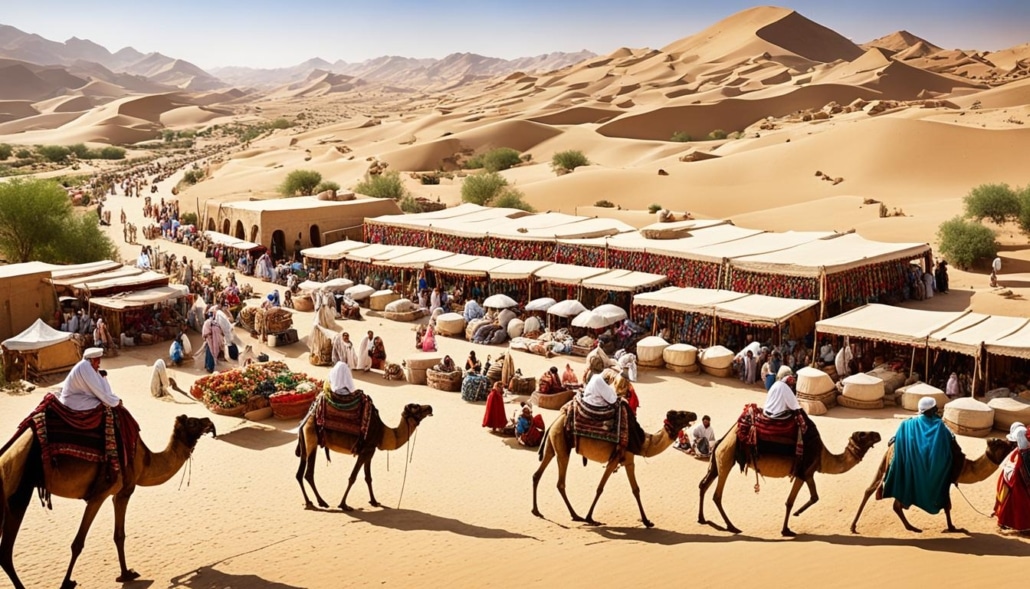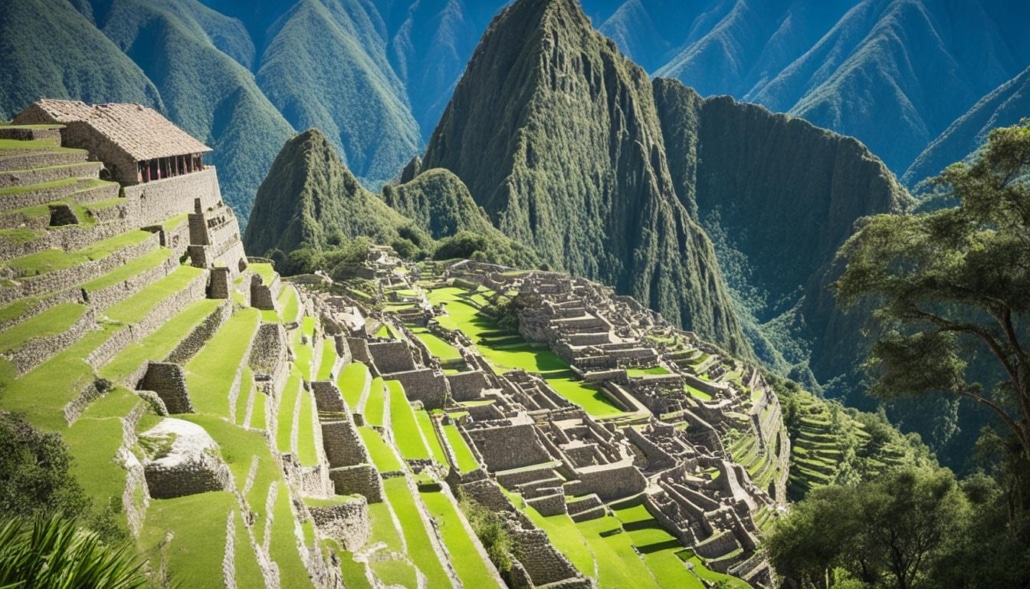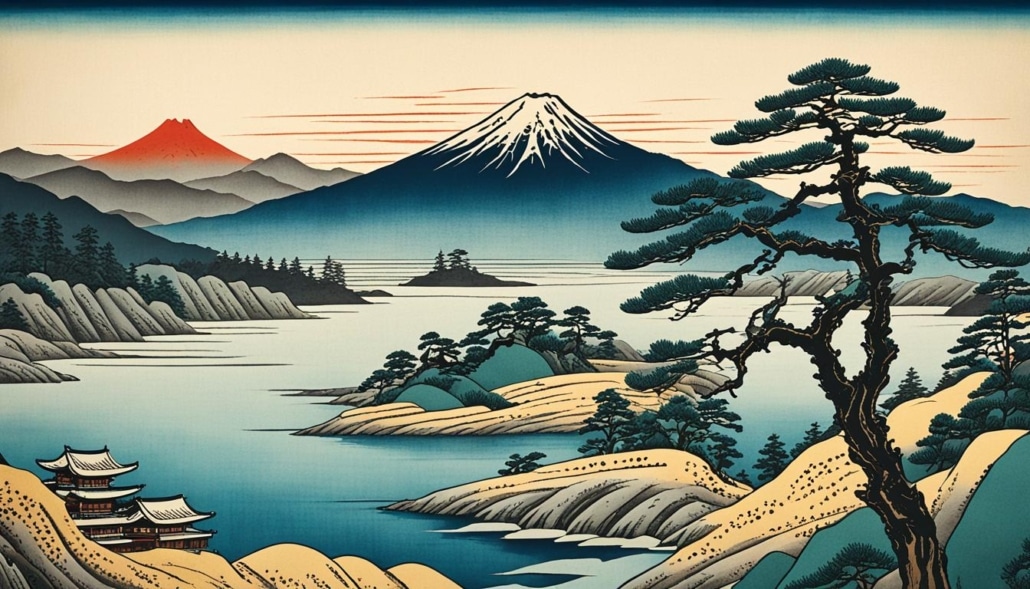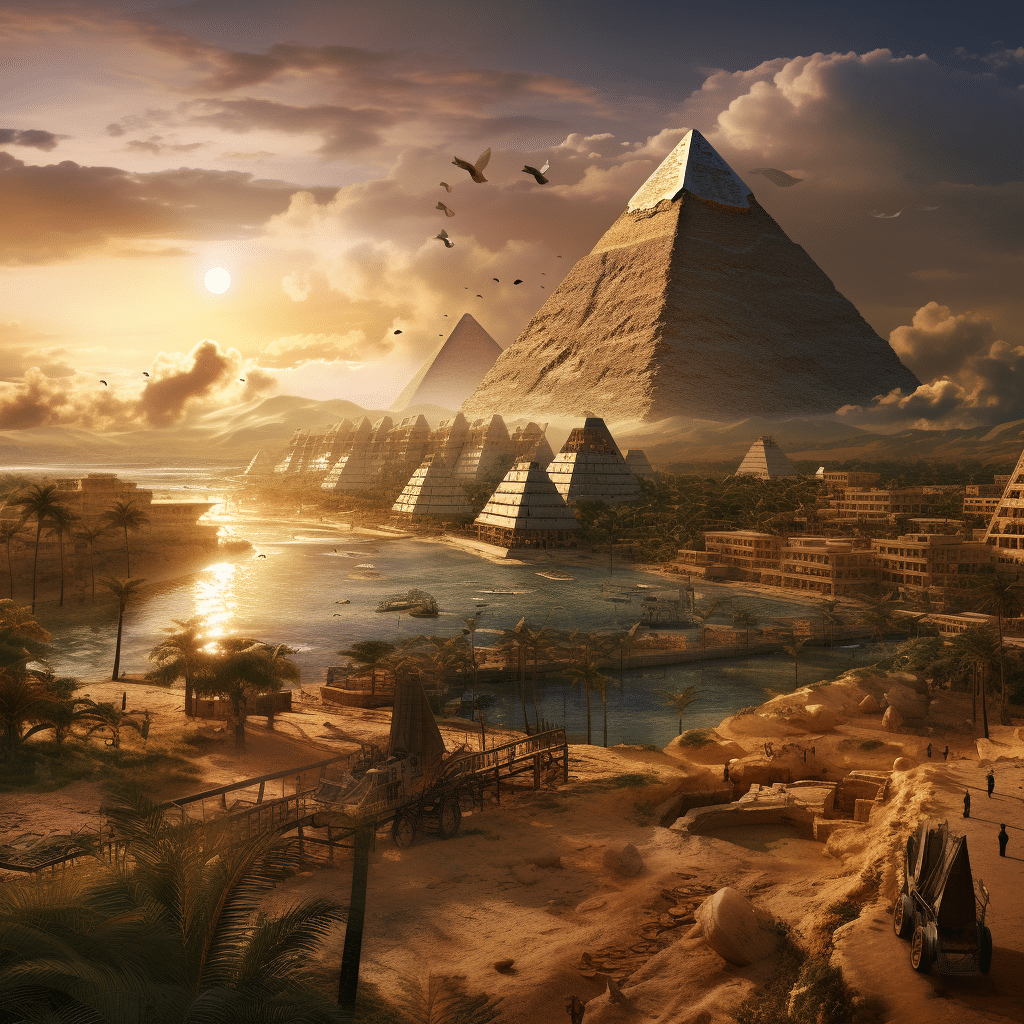Step back in time and embark on a remarkable journey along the Silk Road, an ancient trade route that spanned across Eurasia, connecting the Orient and the Occident. The Silk Road holds a romanticized perception and continues to beckon adventurous travelers to explore the exotic empires it once connected. By retracing the steps of ancient traders, you can immerse yourself in rich cultural experiences and uncover the historical significance of this iconic trade route.
Key Takeaways:
- Discover the cultural experiences and historical significance of the ancient Silk Road.
- Immerse yourself in the vibrant cultures and diverse landscapes that once thrived along this trade route.
- Rediscover the legacy of the Silk Road and witness the incredible cultural exchange it facilitated.
- Explore historical sites and monuments associated with the Silk Road to gain a deeper understanding of its impact.
- Retrace the footsteps of history and engage in immersive experiences that showcase local traditions.
Rediscovering the Ancient Silk Road
The ancient Silk Road has captivated travelers from all walks of life throughout the centuries. It was a thriving trade route that united different cultures and allowed for the exchange of goods, ideas, and traditions. Exploring the Silk Road offers a unique opportunity to immerse oneself in the rich history and vibrant cultures that once thrived along this ancient trade route.
From experiencing exotic cultures to being captivated by natural landscapes and exploring archaeological sites, the Silk Road has much to offer to every traveler seeking cultural experiences. The historical legacy of the Silk Road is a testament to the enduring impact of cultural exchange, shaping the world we live in today.
Ancient Trade and Cultural Exchange
The ancient Silk Road was not only a trade route but also a platform for the exchange of knowledge and ideas. Merchants, scholars, and explorers traversed vast distances, facilitating cultural exchange between the East and the West. The Silk Road acted as a bridge, connecting civilizations and fostering a vibrant melting pot of customs, languages, and beliefs.
“The Silk Road has played a crucial role in shaping the world we inhabit, influencing art, architecture, religion, and even cuisine.”
Throughout history, the Silk Road witnessed the rise and fall of empires, the spread of religions such as Buddhism, Islam, and Christianity, and the flourishing of trade in valuable commodities like silk, spices, and precious metals. The historical legacy of the Silk Road still resonates in the diverse cultures and traditions found along its ancient paths.
An Ancient Trade Route Flourishes Again
The Incense Road, an integral part of the ancient Silk Road, was a network of trails that connected the Mediterranean Coast of Syria to the Red Sea coast of Edom and Yemen. Today, there is a resurgence of activities along the Incense Road, driven by the desire for cultural and economic revival.
Arab countries are investing in infrastructure development to facilitate smoother passage for caravans and attract more merchants and tourists. This includes road construction projects to improve connectivity and accessibility. By revitalizing the Incense Road, these countries aim to rekindle the spirit of cultural exchange and economic prosperity that characterized the ancient Silk Road.
The modern Silk Road, also known as the Belt and Road Initiative, is a global development strategy that seeks to enhance connectivity and economic cooperation between countries. It focuses on reviving and modernizing trade routes through extensive infrastructure development, including road, rail, and maritime projects. The modern Silk Road initiative further emphasizes the relevance and significance of ancient trade routes in the modern world.
“The revival of the Incense Road and the modern Silk Road signifies an exciting era of cultural and economic revival. By investing in infrastructure and promoting trade, countries along these routes aim to unleash the true potential of cultural exchange, fostering lasting partnerships and ensuring a brighter future for all.”
The flourishing of the Incense Road and the modern Silk Road demonstrates the enduring legacy of the ancient Silk Road. It encapsulates the resilience and adaptability of trade routes throughout history, showcasing their ability to evolve with the changing times and continue to contribute to cultural enrichment and economic growth.
Comparison of Ancient and Modern Trade Routes
| Aspect | Ancient Silk Road | Modern Silk Road |
|---|---|---|
| Geographical Scope | Spanned across Eurasia, connecting the Orient and the Occident | Global in nature, connecting Asia, Europe, Africa, and beyond |
| Means of Transport | Mainly camel caravans and horses | Roads, railways, airways, and seaports |
| Infrastructure Development | Relatively primitive infrastructure, focused on trade posts, fortifications, and rest stops | Extensive infrastructure development, including modern roads, railways, and ports |
| Economic Impact | Facilitated trade in silk, spices, precious metals, and other goods, stimulating economic growth in various regions | Promotes economic cooperation, trade diversification, and investment opportunities across participating countries |
| Cultural Exchange | Facilitated the exchange of ideas, technologies, and traditions between different civilizations | Promotes cultural exchange and mutual understanding among diverse communities |
Exploring the Historical Landscape of the Silk Road
The Silk Road, a vast network of trading routes connecting Asia and Europe, played a pivotal role in facilitating the exchange of goods, cultures, and ideas. Today, there are numerous historical sites and monuments along the Silk Road that offer a glimpse into its vibrant history. From the awe-inspiring Steppes of Central Asia to the majestic Great Wall of China, these landmarks provide valuable insights into the legacy of this ancient trade route.
One of the notable historical sites along the Silk Road is the Steppes of Central Asia. These vast grasslands were traversed by nomadic tribes and served as a significant trading route. They offer a unique perspective into the nomadic lifestyle and the exchange of goods between different regions.
The Great Wall of China, another remarkable landmark, stands as a testament to the engineering prowess and defensive strategies employed along the Silk Road. Stretching across thousands of miles, the Great Wall served as a protective barrier and facilitated control over trade routes passing through China.
“The historical sites and monuments associated with the Silk Road provide valuable insights into the vibrant history of the ancient trade route.”
The camel caravans, a symbol of the Silk Road, also left their mark on the historical landscape. These caravan routes allowed traders to transport goods across vast distances, navigating challenging terrains and arid deserts. The presence of ancient caravanserais, resting places for the caravans, serves as a reminder of the bustling trading activity along the Silk Road.
Exploring these historical sites and monuments is an opportunity to delve into the rich history of the Silk Road and gain a deeper understanding of the trade system that once connected civilizations. By walking in the footsteps of ancient traders, visitors can witness the enduring legacy and cultural significance of this historic trade route.
Glimpsing the Incredible Cultural Exchange of the Silk Road
The Silk Road was not only a trade route but also a hub of cultural exchange. It brought together diverse cultures, languages, and belief systems, fostering a unique exchange that resonates even today.
Traveling along the Silk Road provides a glimpse into the incredible cultures that have shaped our world. From the exotic art, architecture, music, and fashion in Central Asia to the mystical writing styles, stories, and philosophies found in the Middle East, the Silk Road offers a window into the rich tapestry of human history and cultural diversity.
“The Silk Road was not just a trade route, but a living artery of cultural exchange and diffusion of ideas.”
As merchants traveled the Silk Road, they not only exchanged goods but also shared their traditions, rituals, and knowledge. This cultural exchange along the Silk Road has had a lasting impact on the regions it traversed. It influenced art, architecture, literature, and even cuisine, as diverse cultures blended and left their mark on one another.
Artistic Traditions of the Silk Road
- Central Asian art was influenced by Chinese and Persian styles, resulting in a unique fusion that combined intricate patterns and vibrant colors.
- Buddhist art, with its serene statues and intricate mandalas, spread across the Silk Road, leaving a lasting cultural imprint.
- The richly decorated ceramics and textiles of Samarkand in Uzbekistan showcase the intricate craftsmanship of the region.
The Intellectual Influence of the Silk Road
- The spread of Buddhism from India to China and Japan was facilitated by the Silk Road, leading to the establishment of Buddhist monasteries and the translation of Buddhist texts into various languages.
- The Islamic Golden Age flourished along the Silk Road, with scholars exchanging ideas and contributing to advancements in science, medicine, astronomy, and philosophy.
- Philosophical ideas from Ancient Greece, such as Stoicism and Epicureanism, were introduced to the East through the Silk Road.
“The Silk Road was a bridge that connected distant lands, fostering a cultural intermingling that shaped civilizations.”
The cultural exchange along the Silk Road was not limited to art and intellectual pursuits. It had a profound impact on everyday life, from fashion and cuisine to language and customs. Each city along the route had its own unique blend of cultures, resulting in a tapestry of traditions that can still be seen in the vibrant communities of Central Asia, the Middle East, and beyond.
By retracing the footsteps of ancient traders along the Silk Road, travelers have the opportunity to witness firsthand the enduring influence of this cultural exchange. They can explore archaeological sites, visit historic cities, and engage with local communities, immersing themselves in the vibrant cultures that continue to flourish along the Silk Road today.
Retracing the Footsteps of History Along the Roads of the Ancient Silk Road
Traveling through the cities and villages of Central and Western Asia offers a truly immersive experience in the diverse landscapes and local cultural history that once thrived along the ancient Silk Road. From the undulating desert sands of Urumqi to the alpine valleys of Kyrgyzstan and the bustling markets of Tajikistan, each destination along the Silk Road presents a unique set of experiences that will captivate and inspire travelers.
Immerse yourself in the vibrant culture of Central Asia as you explore local traditions, taste authentic delicacies, and witness architectural wonders that showcase the region’s rich heritage. The Silk Road traverses through awe-inspiring landscapes, ranging from harsh deserts to lush mountain ranges, providing a breathtaking visual journey as you follow in the footsteps of history.
“Traveling through the Silk Road is like stepping back in time and witnessing the convergence of diverse cultures,” says Sarah Thompson, a seasoned traveler who recently explored the region. “The diversity of landscapes and the authenticity of local traditions make it a truly immersive experience that should not be missed.”
During your journey, don’t miss the opportunity to visit UNESCO World Heritage Sites like the ancient city of Bukhara in Uzbekistan, with its stunning architecture and rich history, or the majestic ruins of Merv in Turkmenistan, a testament to the once thriving Silk Road civilizations. Explore the vibrant bazaars where merchants once traded silks, spices, and precious gems, and witness the enduring influence of the Silk Road on local cultures.
By retracing the footsteps of history along the roads of the ancient Silk Road, you can gain a deeper appreciation for the diverse landscapes, the enduring legacy of local traditions, and the immersive experiences that this historic trading route has to offer.
Conclusion
The Silk Road is more than just a historical trade route; it is an enduring legacy that continues to captivate travelers and historians alike. Exploring the ancient Silk Road offers a unique opportunity to embark on a journey through time, delving into the historical influences that have shaped our world.
Rediscovering the Silk Road allows us to witness the incredible cultural exchange that occurred along its routes. From the diverse languages and belief systems to the vibrant art, architecture, and fashion, the Silk Road served as a melting pot of cultures. Glimpsing into this cultural exchange offers a window into the rich tapestry of human history and a deeper appreciation for our shared heritage.
Retracing the footsteps of history along the Silk Road is not only a historical exploration but a modern-day adventure. Immersing oneself in the diverse landscapes and local traditions of Central and Western Asia provides a truly immersive experience. From the undulating desert sands to the alpine valleys and bustling markets, every destination along the Silk Road offers its own unique charm and set of experiences.
Embarking on this extraordinary journey ensures a memorable and enriching travel experience, where historical exploration meets modern-day adventure. The Silk Road remains a testament to the enduring legacy of human ingenuity, trade, and cultural exchange. It is a living testament to the interconnectedness of our world and a reminder of the rich history that has shaped our present.
FAQ
What is the Silk Road?
The Silk Road was an ancient trade route that connected the Orient and the Occident, allowing for the exchange of goods, cultures, and ideas.
Why is the Silk Road significant?
The Silk Road played a vital role in fostering cultural exchange and shaping world history. It connected diverse cultures and facilitated the spread of goods, traditions, and knowledge.
What are some historical sites along the Silk Road?
There are numerous historical landmarks along the Silk Road, including the Steppes of Central Asia, the Great Wall of China, and the camel caravans. These sites offer insights into the vibrant history of the trade route.
What can I experience while traveling along the Silk Road?
Traveling along the Silk Road offers a chance to immerse yourself in diverse landscapes, local cultural history, and architectural wonders. You can also try local delicacies and explore vibrant markets along the way.
How does the modern Silk Road revival impact travel?
The modern Silk Road revival, known as the Belt and Road Initiative, is driving infrastructure development and attracting more merchants and tourists to the ancient trade routes. This offers new opportunities for cultural exploration and economic growth.
What can I gain from exploring the Silk Road?
Exploring the Silk Road allows for a deeper understanding of historical influences, cultural diversity, and the lasting legacy of the trade route. It combines historical exploration with modern-day adventure, creating a memorable travel experience.










